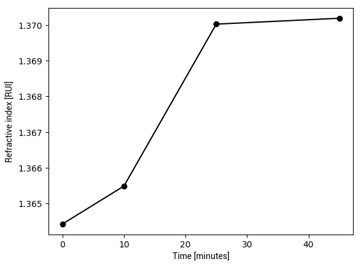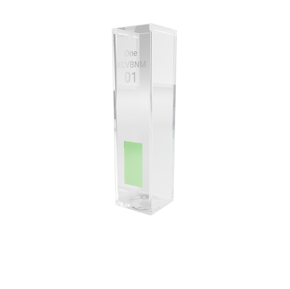Saliva and starch degradation
NanoCuvette™ One can be used to study the degradation of starch over time by amylase enzymes from saliva.
Download pdf here.
Starch and amylase enzymes
An enzyme is a biomolecule which catalyse chemical reactions by increasing the reaction rate without itself being affected. Enzymes can be found in nature, for example in human body fluids such as saliva. Human saliva contains the enzyme amylase, which is important for food digestion. As an example, starch must be broken down into smaller disaccharides before digestion. Saliva is rich on amylase which is specialized to break down starch, allowing the body to easier digest the food.
Quality control
Amylase is an important enzyme in brewing, baking and producing medicine. To ensure proper production quality it is important to control the enzyme activity. The enzyme activity is usually measured in a two step process using an enzyme assay. The assay can either measure on the disappearance of starch or the appearance of disaccharides. To measure either of these, the first step is to add a reactant, which for example enables a color readout. In a second step, the color can be quantified spectrophotometrically and the enzyme activity measured. By the use of NanoCuvette™ One, the enzyme activity is measured on a conventional spectrophotometer without the need for adding a reactant. In one process step, the refractive index can be measured and provide information on the enzyme activity, thereby allowing for easy quality control.
Principle
The novel NanoCuvette™ One has a build-in optical filter, which allows for determination of refractive index using a conventional spectrophotometer. The enzyme activity changes the refractive index of the solution, thereby allowing the NanoCuvette™ One to measure the enzyme activity (Figure 1).

Figure 1. Refractive index as a function of time for solution with starch broken down by amylase enzymes from saliva.
Safety precautions
This method does not entail any safety precautions. Please refer to common laboratory practices.
Measurement
- Materials and apparatus
The only apparatus required is a conventional spectrophotometer and a computer with internet access. For each measurement, a NanoCuvette™ One is required. - Sample preparation
A 1 % starch solution is prepared by first weighing 1 g of starch (Maizena) and mixing it with 5 mL cold deionized (DI) water, and subsequently adding it to 95 mL gently boiling water while stirring until the starch is fully dissolved. Let it cool to room temperature, then add 300 μL saliva. Mix well before each measurement. - Measurement procedure
The spectrophotometer and computer are switched on and the online NanoCuvette™ One software is opened in a web browser. A NanoCuvette™ One (Figure 2) is used for the refractive index measurements over time by following the software guidance for each measurement. For each measurement, the software will present the refractive index of the enzyme solution, and this can be displayed as a function of time or other variables, depending on the experimenter’s preferred choice of representation.
 Figure 2: NanoCuvetteTM One measures refractive index and absorbance for the same sample, using only a conventional spectrophotometer and the online NanoCuvetteTM software.
Figure 2: NanoCuvetteTM One measures refractive index and absorbance for the same sample, using only a conventional spectrophotometer and the online NanoCuvetteTM software.
Contact
www.nanocuvette.com